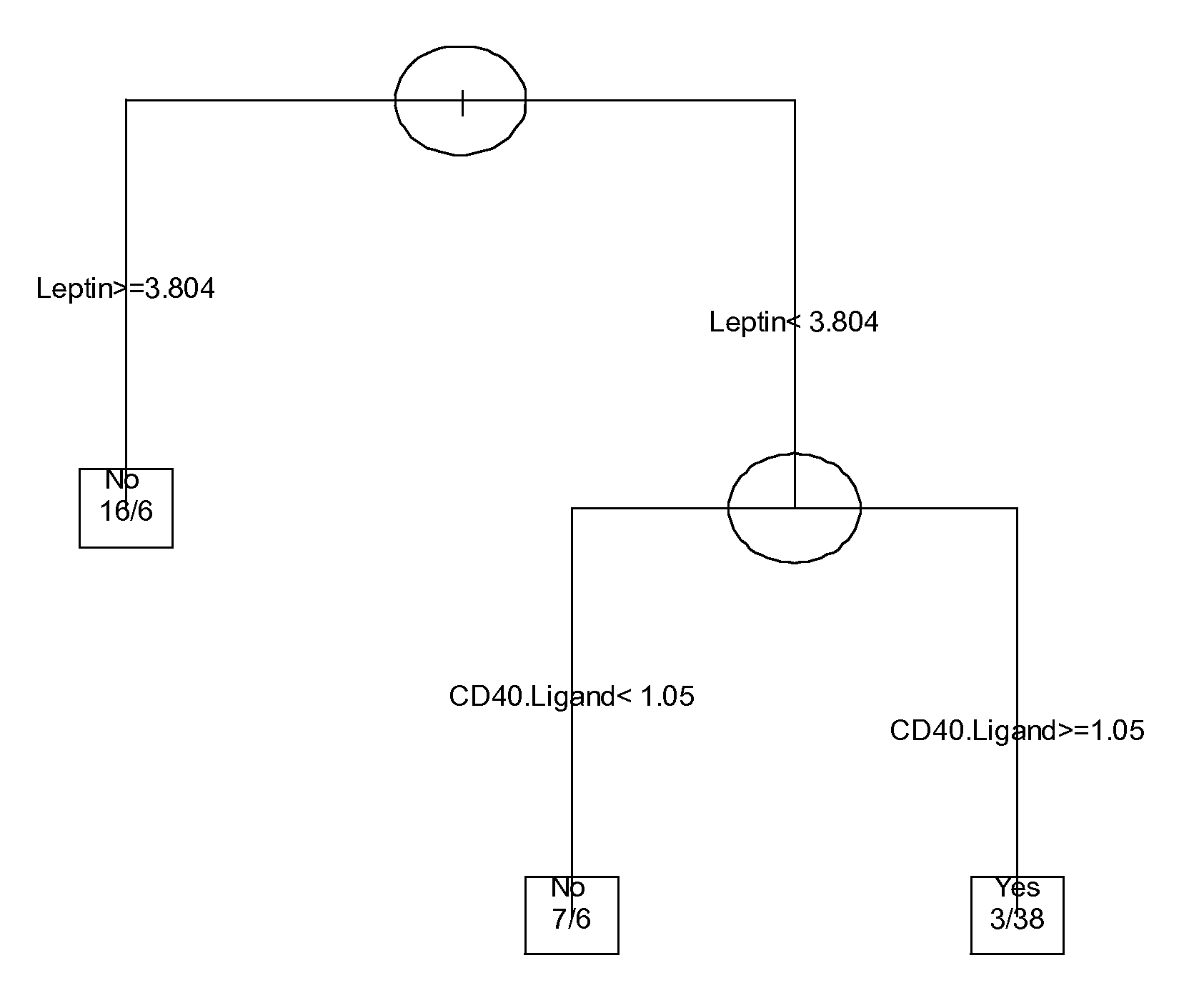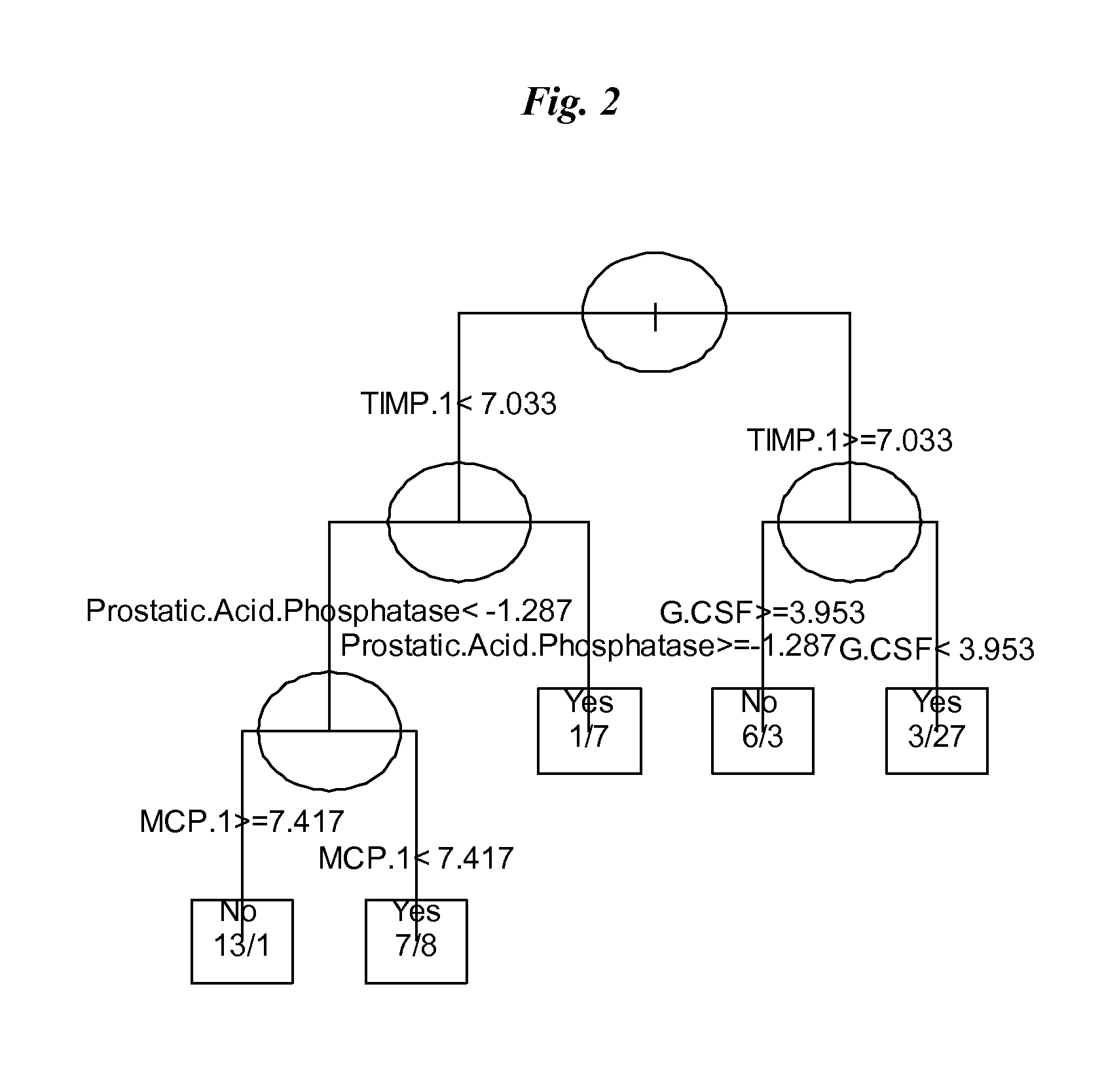SERUM MARKERS PREDICTING CLINICAL RESPONSE TO ANTI-TNFa ANTIBODIES IN PATIENTS WITH ANKYLOSING SPONDYLITIS
a clinical response and antibody technology, applied in the field of serum markers predicting clinical response to antitnfa antibodies in patients with ankylosing spondylitis, can solve the problems of undiscovered unique set of markers and a predictive algorithm
- Summary
- Abstract
- Description
- Claims
- Application Information
AI Technical Summary
Benefits of technology
Problems solved by technology
Method used
Image
Examples
example 1
Sample Collection and Analysis
[0138]Serum samples were obtained and evaluated from patients enrolled in Centocor Protocol C0524T09, a multicenter, randomized, double-blind, placebo-controlled, 3-arm study. The three groups consist of a placebo and two dose levels of anti-TNFa Mab treatment; golimumab 50 mg, or golimumab 100 mg administered as SC injections every 4 weeks in patients with active Ankylosing Spondylitis. Primary efficacy assessments were made at week 14 and week 24. The serum samples for the biomarker study were collected from 100 patients at baseline (Week 0), Week 4, and Week 14.
[0139]The sera were analyzed for biomarkers using commercially available assays employing either a multiplex analysis performed by Rules Based Medicine (Austin, Tex.), or single analyte ELISA. All samples were stored at −80° C. until tested. The samples were thawed at room temperature, vortexed, spun at 13,000×g for 5 minutes for clarification and 150 uL was removed for antigen analysis into a...
example 2
Marker and Association
[0145]In order build a predictive model or algorithm, the marker data was evaluated in association with the study clinical endpoints. There were six clinical endpoints in this study, defined as ASAS20 Week 14, ASAS20 Week 24, Change in BASMI Week 14, Change in BASFI Week 14, and the Change in BASDAI Week 14. These study endpoints are generally accepted clinical methods to evaluate disease status in patients. The 100 patients in the protein biomarker sub-study and the study endpoints collected are shown below (Table 6).
TABLE 6PatientsClinicalwhoEndpointEnrolled inBaselineWeek 4Week 14qualifiedDataProteinpatientpatientpatientfor EarlyAvailableTreatmentBiomarkerDataDataDataEscape atat WeeksGroupsub- studyCollectedCollectedCollectedWeek 1614 / 24Placebo2424 / 2424 / 2424 / 2414 / 24 24 / 24(100%)(100%)(100%)(58%)(100%)Gol 50 mg3737 / 3737 / 3737 / 379 / 3737 / 37(100%)(100%)(100%)(24%)(100%)Gol 100 mg3939 / 3939 / 3939 / 399 / 3939 / 39(100%)(100%)(100%)(23%)(100%)Total100100 / 100100 / 100100 / 10032 / ...
example 3
Prediction Model Building
[0148]Biomarkers were assessed for association at baseline, week 4, and week 14. Several findings emerged from these analyses. Few of the 92 markers examined were significantly associated with clinical response. Markers that did showed significant effects, and the marker and endpoint relationship for these markers, was generally consistent across the several primary and secondary endpoints. As there was no dose effect on the clinical outcomes, the data used was combined golimumab treatment groups (all patients receiving golimumab). Biomarkers were assessed for an association at baseline, week 4, and week 14.
[0149]All analysis was performed using R (R: A Language and Environment for Statistical Computing, 2008, Author: R Development Core Team, R Foundation for Statistical Computing, Vienna, Austria, ISBN 3-900051-07-0). Change from baseline was tested using one-sample t-tests. Association of clinical factors with baseline biomarkers was evaluated using robust...
PUM
| Property | Measurement | Unit |
|---|---|---|
| time | aaaaa | aaaaa |
| concentration | aaaaa | aaaaa |
| concentrations | aaaaa | aaaaa |
Abstract
Description
Claims
Application Information
 Login to View More
Login to View More - R&D
- Intellectual Property
- Life Sciences
- Materials
- Tech Scout
- Unparalleled Data Quality
- Higher Quality Content
- 60% Fewer Hallucinations
Browse by: Latest US Patents, China's latest patents, Technical Efficacy Thesaurus, Application Domain, Technology Topic, Popular Technical Reports.
© 2025 PatSnap. All rights reserved.Legal|Privacy policy|Modern Slavery Act Transparency Statement|Sitemap|About US| Contact US: help@patsnap.com



